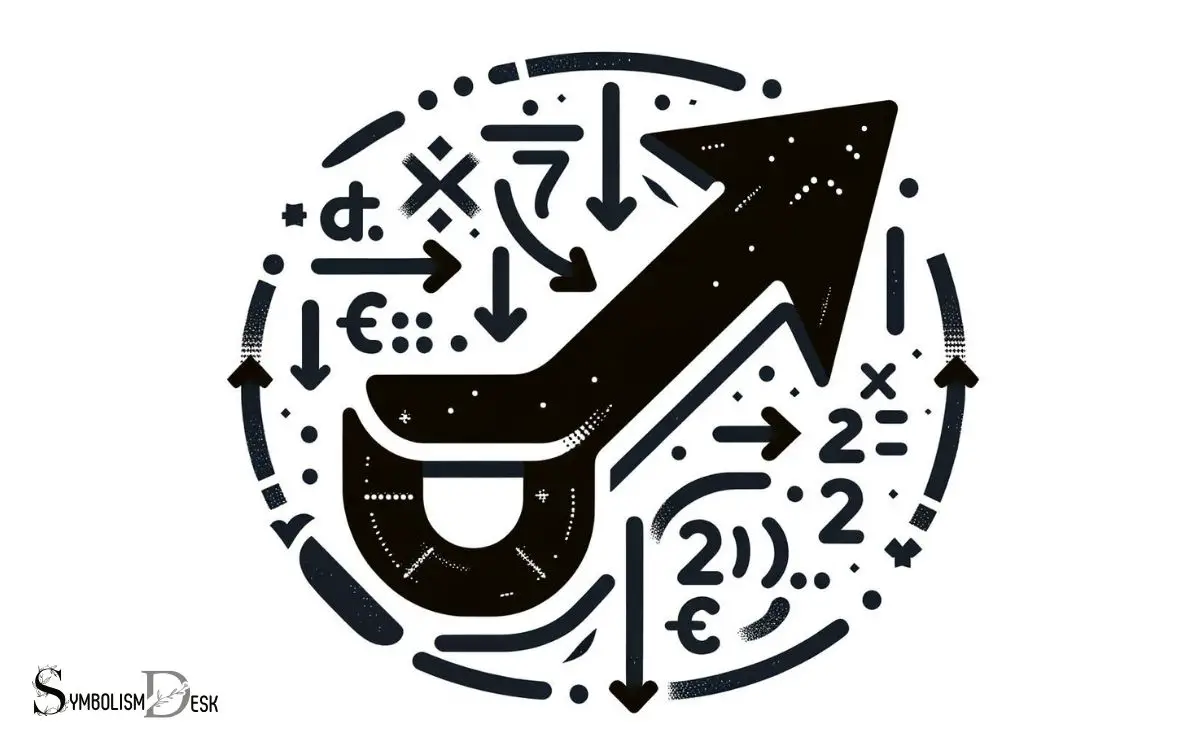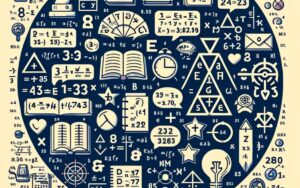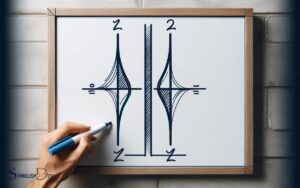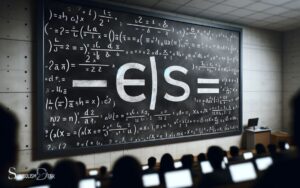Right Arrow Symbol in Math: Set Theory!
The right arrow symbol (→) in math is commonly used to express a range of concepts including function mapping, logical implication, and sequence limits. Its versatility is seen in different branches of mathematics like calculus, set theory, and propositional logic.
The right arrow symbol has specific meanings in various mathematical contexts:
Examples: – For a function f(x) = x^2, the mapping of x to f(x) is written as x → x^2. – In logic, “If it rains, then the ground is wet” is written as “rains → wet”.
The right arrow symbol guides mathematicians in understanding processes and logical flow within equations and theories.

Key Takeaway
Origin and Meaning
The right arrow symbol in math originates from and signifies the direction or mapping of one element to another within a mathematical context.
It is used to represent the relationship between two quantities, often indicating the flow or transition from one value to another.
In equations, the right arrow symbol is employed to denote the transformation or operation that occurs on a given input to produce a specific output.
This notation is fundamental in various mathematical fields, including algebra, calculus, and set theory, where it serves as a concise and precise way to express mathematical relationships and functions.
Understanding the origin and meaning of the right arrow symbol is crucial for interpreting mathematical expressions and comprehending the fundamental concepts of mathematical operations and transformations.
Representation in Equations
In mathematical equations, the right arrow symbol holds a symbolic meaning, representing the direction of a mathematical relationship or transformation.
Its practical applications in mathematics are diverse, ranging from indicating the flow of operations in sequences to denoting the mapping of elements between sets.
These points will be further explored to provide a comprehensive understanding of the representation of the right arrow symbol in equations.
Symbolic Meaning in Equations
Symbolically, the right arrow symbol is often used to represent a one-way relationship in mathematical equations.
In equations, the right arrow signifies a directional flow from one mathematical expression to another, indicating the direction in which a transformation or operation is applied.
For instance, in functions, the right arrow denotes the mapping of input values to output values. It is a concise way to show the relationship between different elements in an equation, making it easier to understand the flow of operations or transformations.
The right arrow symbol is a powerful tool for denoting causality, implication, or transition within mathematical expressions.
Its implementation aids in visually organizing and interpreting equations, enabling individuals to comprehend the sequential and logical progression of mathematical operations.
Practical Applications in Math
How does the right arrow symbol specifically illustrate practical applications in mathematical equations? The right arrow symbol, often denoted as ‘→’, is commonly used in mathematical equations to represent various relationships and transformations.
For instance, in linear algebra, it can be utilized to denote the mapping of vectors from one space to another. In set theory, it is employed to indicate the mapping of elements from one set to another.
In practical applications, the right arrow symbol helps in expressing processes such as transformations, transitions, and directional flows within mathematical contexts.
Its usage provides a concise and clear representation of mathematical operations, making it a valuable tool for conveying complex relationships and operations within equations.
This practical application of the right arrow symbol seamlessly transitions into its role in mathematical functions.
Role in Mathematical Functions
The right arrow symbol is an essential tool in mathematical functions, often used to denote the mapping of elements from one set to another.
Its role in indicating the direction of a mathematical operation or relationship is significant, providing a clear and concise way to express the function’s behavior.
Understanding its usage in functions and its representation of direction is crucial for effectively interpreting mathematical expressions and equations.
Symbol Usage in Functions
Frequently used in mathematical expressions, the right arrow symbol plays a crucial role in denoting the relationship between the domain and codomain of a function.
When used in functions, the right arrow symbol signifies the mapping of elements from the domain to the codomain.
For instance, in the function f: A → B, the right arrow symbol → indicates that for every element x in the domain A, there exists a corresponding element f(x) in the codomain B. This notation helps to clearly define the input-output relationship within the function.
It is important for conveying the specific rules or operations that determine how elements in the domain are transformed into elements in the codomain.
As a result, the right arrow symbol serves as a fundamental tool for understanding and representing mathematical functions.
Representation of Direction
Representing directional relationships in mathematical functions, the right arrow symbol plays a pivotal role in defining the mapping of elements from the domain to the codomain. Its significance lies in its ability to convey the direction of the mapping and the relationship between sets.
In mathematical functions, the right arrow symbol serves the following purposes:
- Indicates the direction of the mapping from the domain to the codomain.
- Communicates the transformation or operation applied to the input.
- Defines the relationship between input and output.
- Represents the flow of data or information within the function.
- Conveys the order of operations or sequence of events within the function.
Understanding the role of the right arrow symbol in mathematical functions is crucial for comprehending the mapping and transformations that occur within various mathematical contexts.
Use in Set Notation
When using the right arrow symbol in math for set notation, it is important to understand how it indicates the mapping of elements from one set to another. In set notation, the right arrow symbol (→) is used to show the relationship between the elements of two sets. Math symbols explained can be helpful for understanding the relationship between sets and how elements are mapped from one set to another. This notation is commonly used in functions, relations, and other mathematical concepts to show the connection between different sets of numbers or objects. By understanding the meaning of the right arrow symbol and other math symbols explained, mathematicians and students can more easily interpret and communicate complex mathematical ideas.
For instance, if we have sets A and B, and there is a function f that maps elements from set A to set B, we can represent this using set notation as f: A → B.
This indicates that each element in set A is mapped to a unique element in set B. The right arrow symbol is crucial in conveying this mapping relationship, providing a clear and concise representation of how elements are related between sets in mathematical contexts.
Implications in Logic and Implication
The implication of the right arrow symbol in logic signifies a fundamental relationship between propositions.
When delving into implications in logic, it is crucial to understand the following:
- Conditional Statements: The right arrow symbol is commonly used to represent conditional statements in logic.
- Truth Tables: Implications can be analyzed using truth tables to determine the validity of the relationship between propositions.
- Logical Consequences: The right arrow symbol indicates the logical consequence between antecedent and consequent propositions.
- Formal Proofs: In formal proofs, implications are often utilized to establish the validity of arguments and logical reasoning.
- Mathematical Reasoning: Understanding implications in logic is essential for various fields, including mathematics, computer science, and philosophy.
Applications in Vector Notation
Applications of the right arrow symbol in vector notation are prevalent in mathematical representations of directional quantities. In vector notation, the right arrow symbol is used to denote a vector quantity, which has both magnitude and direction.
This notation is extensively used in various fields such as physics, engineering, and computer science to represent forces, velocities, accelerations, and displacements.
For instance, in physics, when representing the force acting on an object, the force vector is denoted by a bold letter with a right arrow on top (e.g., F→).
Similarly, in computer graphics, the right arrow symbol is used to represent 2D and 3D geometric transformations.
Understanding the applications of the right arrow symbol in vector notation is crucial for accurately representing and analyzing directional quantities in mathematical contexts.
Significance in Sequences and Series
In the context of sequences and series, the right arrow symbol retains its importance as a representation of directed quantities, facilitating the precise depiction and analysis of mathematical progressions.
Its significance in this domain is evident in various ways:
- Symbolic representation of the relationship between consecutive terms.
- Indication of the direction of growth or decay in a sequence or series.
- Utilization in defining recursive sequences and series.
- Representation of mathematical operations such as summation and product notations.
- Facilitation of concise and clear articulation of mathematical patterns and progressions.
Understanding the role of the right arrow symbol in sequences and series is essential for effectively analyzing and manipulating these mathematical constructs.
This understanding forms a foundational basis for its incorporation in graph theory, as explored in the subsequent section.
Incorporation in Graph Theory
Incorporation of the right arrow symbol in graph theory enhances the representation and analysis of interconnected relationships among abstract entities. This symbol, often denoted as “→”, is utilized to depict directed edges or relationships between nodes in a graph.
By incorporating the right arrow symbol, graph theory can effectively model various real-world systems such as transportation networks, social structures, and information flow.
The table below illustrates a simple directed graph using the right arrow symbol for edge representation:
| Node A | Node B | Relationship |
|---|---|---|
| 1 | 2 | A → B |
| 2 | 3 | B → C |
| 3 | 1 | C → A |
This incorporation allows for a more nuanced analysis of connectivity and pathways within graph structures.
Conclusion
The right arrow symbol in math, with its origins in logic and implication, plays a significant role in representing mathematical functions, set notation, vector notation, sequences and series, and graph theory.
Its use in equations and its implications in various mathematical concepts make it a versatile and essential symbol in the language of mathematics, providing a visual representation of relationships and transformations.






